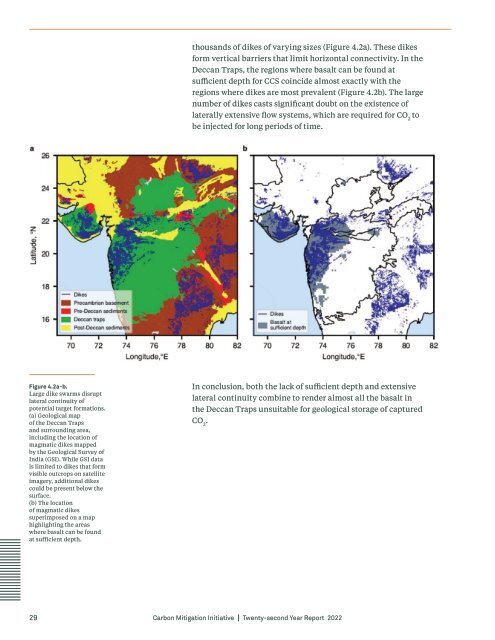CMI Annual Report 2022
You also want an ePaper? Increase the reach of your titles
YUMPU automatically turns print PDFs into web optimized ePapers that Google loves.
thousands of dikes of varying sizes (Figure 4.2a). These dikes<br />
form vertical barriers that limit horizontal connectivity. In the<br />
Deccan Traps, the regions where basalt can be found at<br />
sufficient depth for CCS coincide almost exactly with the<br />
regions where dikes are most prevalent (Figure 4.2b). The large<br />
number of dikes casts significant doubt on the existence of<br />
laterally extensive flow systems, which are required for CO 2<br />
to<br />
be injected for long periods of time.<br />
Figure 4.2a-b.<br />
Large dike swarms disrupt<br />
lateral continuity of<br />
potential target formations.<br />
(a) Geological map<br />
of the Deccan Traps<br />
and surrounding area,<br />
including the location of<br />
magmatic dikes mapped<br />
by the Geological Survey of<br />
India (GSI). While GSI data<br />
is limited to dikes that form<br />
visible outcrops on satellite<br />
imagery, additional dikes<br />
could be present below the<br />
surface.<br />
(b) The location<br />
of magmatic dikes<br />
superimposed on a map<br />
highlighting the areas<br />
where basalt can be found<br />
at sufficient depth.<br />
In conclusion, both the lack of sufficient depth and extensive<br />
lateral continuity combine to render almost all the basalt in<br />
the Deccan Traps unsuitable for geological storage of captured<br />
CO 2<br />
.<br />
29<br />
Carbon Mitigation Initiative Twenty-second Year <strong>Report</strong> <strong>2022</strong>
















